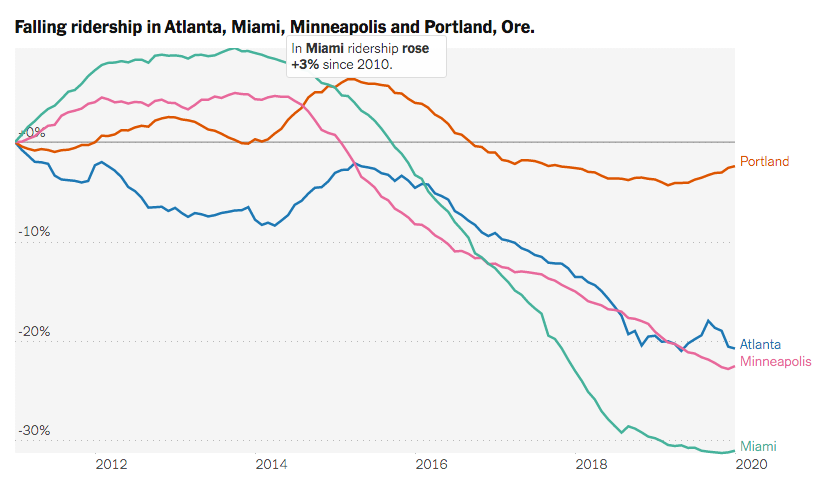We know what’s responsible for declining bus ridership: Cheap gas
And now, its about to get worse, thanks to $30 a barrel oil
Prices matter.
Last Friday’s New York Times has a nice data-driven article by the paper’s very smart Emily Badger and Quoctrung Bui, illustrating the decline in bus ridership in cities across the nation since 2013. It’s called “The Mystery of the Missing Bus Riders.” As usual, they have a great Upshot graphic showing the decline:
And they explain that the decline is widespread:
Sometime around 2013, bus ridership across much of the country began to decline. It dropped in Washington, in Chicago, in Los Angeles, in Miami. It dropped in large cities and smaller ones. It dropped in places that cut service, and in some that invested in it. It dropped in Sun Belt cities where transit has always struggled to compete with the car, and it dropped in older Eastern cities with a long history of transit use.
There’s no question that bus ridership is down since 2013. But, with due respect to the authors: There’s no mystery here. We know exactly “who dunnit.” We have a smoking gun: It was gas prices.
That’s clear when you look at the historical record. HIgh and rising gas prices bumped up transit ridership in the decade prior to 2013. And the collapse of gas prices in 2014 coincides exactly with the decline in ridership. A simple and powerful economic rationale explains what’s going on with transit ridership: There is no mystery. But you’ll be hard pressed to learn this in the Times article.
True, the Times article does mention gas prices: once, in passing, with no data, in the 26th paragraph of the story.
Past research has suggested that transit riders are even more sensitive to changes in gas prices than they are to changes in transit fares. Recently gas has been cheap, and interest rates on auto loans low.
Instead, the story spends most of its time highlighting a number number of other possible explanations: the movement of young people to cities, the increasing share of the white population in some neighborhoods, the growth of Uber and Lyft, the aging of the pre-boomer population and their replacement with boomers, who have little experience with transit. Save possibly for the advent of ride-hailing, the timing of those trends hardly coincides with the decline in bus ridership: There wasn’t a sudden shift in demographic trends in 2014. What did change, suddenly and dramatically was the price of gasoline.
The data on gas prices and transit ridership
Here, we’ve plotted the relationship between gas prices and transit ridership for the nation since 2000. The blue line shows total transit ridership; the red line shows the national average of the price of gasoline. At the turn of the millenium, transit ridership was flat to declining. After 2004, as gas prices started rising, transit ridership rose as well. There was a brief decline in gas prices (and transit ridership) during the Great Recession, but as the economy recovered, from 2009 through 2013, gas prices remained relatively high, and transit ridership continued growing. But, as we’ve noted before at City Observatory, there was a precipitous decline in gasoline prices in the third quarter of 2014, and that coincides exactly with the downturn in transit ridership.
In the second quarter of 2014, retail gasoline prices were more than $3.60 per gallon, and transit agencies carried about 900 million monthly riders. In the first quarter of 2015, gas prices had fallen to about $2.10 per gallon, and ridership was down to 850 million.
Expensive gasoline explains why transit ridership was rising after 2005.
Cheap gasoline explains why transit ridership was falling after 2014.
Can we kindly suggest a kind of economist’s Occam’s Razor here: If you have a salient price that drops by a third or so, wouldn’t you expect that to be the principal reason for the effect you observe? There’s little question that income and demography influence transit ridership, but those are not the factors that changed abruptly in 2014. What did change was the price of driving, and cheap gas is what’s produced the sharp decline in transit ridership in the US.
And that makes this month’s cratering in world oil markets an ominous development for transit agencies. The advent of $30 a barrel oil likely means a 50 cent per gallon reduction in gas prices, which makes driving even more affordable and attractive relative to bus or train travel. If you think bus ridership trends are bad now, just wait. It’s going to get worse.

